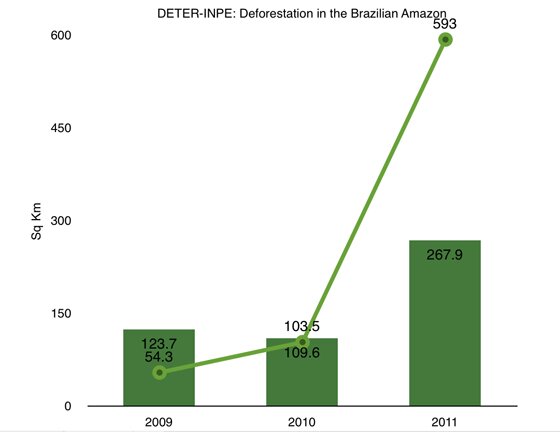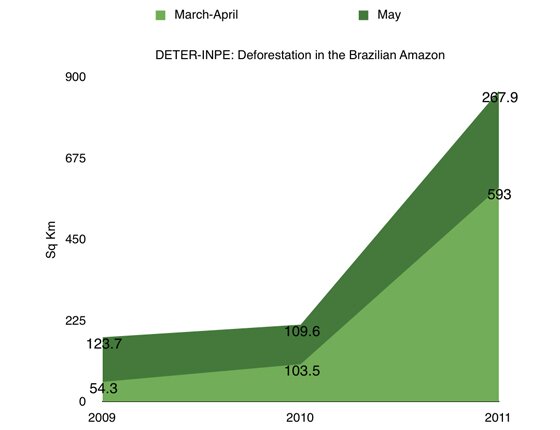Changes in the Forest Act trigger wave of deforestation in the Brazilian Amazon
Sérgio Abranches
The early-warning satellite system for monitoring deforestation in the Brazilian Amazon, DETER, developed by the National Institute for Space Research, INPE, has detected an atypical increase in cleared forest area on March-April this year. It was the largest area cleared in this period since 2008. Compared to 2010 deforestation was 473% greater. Today, INPE has announced that deforestation in May was 146% greater than in May, 2010.
There is a clear trend towards increased land clearing. The chart shows DETER‘s figures for both periods.
Deforestation has been greater in 2011 than in 2009 and 2010. The figure for March-April 2011 is anomalously high because these months close the rainy season. The explanation for this sudden increase in land-clearing even before the dry season begins is the anticipation of the congressional approval of a new Forestry Code.
The bill reduces the mandatory forest reserve in the Amazon from 80% to 50% of the property area, as well as the extension of riparian vegetation to be preserved or restored on both margins of rivers, from 30 to 15 meters. These changes were already approved by the House. If the bill becomes a law, landholders will have to register their properties indicating the areas of mandatory protection. The bill also eliminates fines and administrative and legal proceedings against illegal deforestation until 2008. The likelihood of its approval has triggered “preemptive clearing”, a policy of “fait accomplit”, before the bill is converted into law.
The dry season in the Amazon begins in May. The risk of intentional wildfires and land clearing is at its highest from May through to September. Fire usually comes after the electric saw and the tractor-pulled chain, two common methods of land-clearing. The most devastating one is the use of large freighter anchor chains connected to two high-power tractors that would pull every tree, and kill every animal on their way. This method easily clears near 100 hectares in a day’s work. (See a video .) Fire has also been used to clear drier tracts of native forest. Cleaning up the rest becomes an easy task for a tractor shovel.
The chart with aggregate deforestation areas from March to May gives a clearer picture of the present trend towards higher clearing rates.
INPE has indicated that 81% of the deforested area in March-April was in the state of Mato Grosso, Brazil’s larger soybean and beef producer. In May, 35% of the cleared area was in Mato Grosso; 25% in Rondonia, where the government is building two large and controversial hydropower dams; 24% in Pará, a large beef and timber producer; 11% in the state of Amazonas; and the remaining in the states of Maranhão, Tocantins and Acre.
The state of Mato Grosso has active lobbies and political networks related to the two major traditional drivers of Amazon and Savannah (Cerrado) deforestation: soybean cultivation and cattle ranching. The pressure from soybean cultures over the forest has been smaller for the last 5 years due to the “Soy Deforestation Moratorium” signed in 2006 by Brazilian soy industry representatives, trading companies and large producers, after major U.S. and European consumers refused to continue buying soy from illegally cleared land. This movement was triggered by a well orchestrated campaign from Greenpeace’s Brazilian branch.
A story by Bettina Barros (in Portuguese) for Valor Econômico, a Brazilian daily business newspaper, shows that the soy industry is already considering relaxation of the moratorium due to the upcoming change in the forest law. They argue that their agreement cannot ask more from producers than the law. But the fact is that the “Soy Deforestation Moratorium” did ask more than the law from producers before it became clear that the law was about to be changed.
The motive for ending the ban on soy from illegally deforested areas comes from the market. World soybean prices were quite low by the time the “Moratorium” was signed at US$ 5.50/bushel. Now they are as high as US$ 13.60/bushel.
The market has also changed. Most of the demand in the early 2000’s came from the European Union and the United States. Under the pressure of environmentalists, the media, and their consumers U.S. and EU customers have decided not to buy soy coming from deforested land, and to ask for certification of origin. Today most of the demand comes from China. Chinese buyers ask no questions. They are insensitive to what happens in their supply chain to have their food industry adequately fed.
On another recent story (also in Portuguese), Cláudio Ângelo, a senior reporter for the Brazilian daily newspaper Folha de São Paulo reported that land clearing for soybean plantation had increased by 85% in 2011 in comparison to the area cleared in 2010. He also used data from INPE, and mentioned the incentive from high global soy prices. Senator Blairo Maggi (PR-MT), one of the world’s largest soybean producers told him that prices “have never been that high for the last 70 years.”
Tags: Amazon, beef, Brazil, cattle ranching, deforestation, land-clearing, land-use, logging, soybean, sustainability, timber




